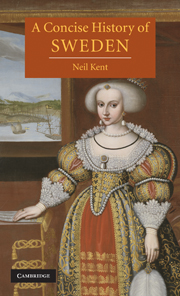Book contents
- Frontmatter
- Contents
- List of illustrations
- Maps
- Preface
- 1 From prehistory to Viking hegemony
- 2 The formation and growth of the Swedish state
- 3 The territorial consolidation of Sweden
- 4 Towards a centralist and military state
- 5 The collapse of absolutism and the Age of Freedom
- 6 Royal absolutism restored
- 7 Constitutional Sweden
- 8 The industrialisation and capitalisation of Sweden
- 9 The world wars and Swedish neutrality
- 10 Triumph of the Swedish welfare state
- Conclusion
- Appendix 1 Chronology
- Appendix 2 Monarchs and regents of Sweden
- Appendix 3 Prime ministers
- Selected further reading
- Index
4 - Towards a centralist and military state
Published online by Cambridge University Press: 05 June 2014
- Frontmatter
- Contents
- List of illustrations
- Maps
- Preface
- 1 From prehistory to Viking hegemony
- 2 The formation and growth of the Swedish state
- 3 The territorial consolidation of Sweden
- 4 Towards a centralist and military state
- 5 The collapse of absolutism and the Age of Freedom
- 6 Royal absolutism restored
- 7 Constitutional Sweden
- 8 The industrialisation and capitalisation of Sweden
- 9 The world wars and Swedish neutrality
- 10 Triumph of the Swedish welfare state
- Conclusion
- Appendix 1 Chronology
- Appendix 2 Monarchs and regents of Sweden
- Appendix 3 Prime ministers
- Selected further reading
- Index
Summary
POLITICAL CONSOLIDATION UNDER THE HEIRS OF GUSTAF VASA
After the death of Gustaf Vasa, Sweden underwent a lengthy period of turbulence which eventually gave way in the following century to a period of consolidation, on a wide variety of levels. In 1560, Erik XIV (1533–77) succeeded his father as king of Sweden, the second in the dynastic line of Vasa. However, the transition was less than smooth since relations with his brother Johan, later Johan III (1537–92), were troubled by the latter’s marriage to the Catholic princess Katarina Jagellonica (1526–83) of Poland and the education of their son Sigismund (1566–1632) as a Catholic. This circumstance would open the door to Sweden’s growing political and military involvement in continental European affairs, in particular those which involved Poland. Unwilling to bend to the will of Erik, Johan was imprisoned for four years. Yet his temporary removal left a wide range of problems unresolved for Erik. His morganatic marriage to his mistress Karin Månsdotter (1550–1612) in 1568 was especially unpopular. The key role played by the jurist Jöran Persson (c.1530–68) in his political decisions also won him many enemies, a situation which the latter’s torture and murder failed to abate. For the murders, in 1567, of members and associates of the powerful, noble Sture family, including Nils, Svante and Erik Sture, as well as Abraham Stenbok, by Erik and his henchmen had been blamed on Persson’s political machinations. In consequence, Erik was removed from power in 1568, imprisoned, and Johan placed upon the throne in his stead. The following year, King Johan III, as a means of appeasing the nobility, promulgated a decree releasing them from military obligations. However, relations with the nobility were also troubled, not least because of Johan’s attempts to re-establish Catholicism in Sweden by stealth. In particular, his introduction of the so-called Red Book, a new but more Catholic liturgy, in 1576 met with considerable opposition. Although in 1571 a new series of pro-Reformation ecclesiastical laws eliminated many of the old Catholic holy days from the calendar, the Protestant Reformers themselves were riven by theological disagreement, as Lutherans and Calvinists vied with one another to dominate the Swedish Church.
- Type
- Chapter
- Information
- A Concise History of Sweden , pp. 61 - 100Publisher: Cambridge University PressPrint publication year: 2008
- 1
- Cited by



